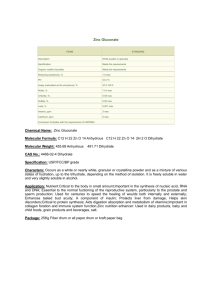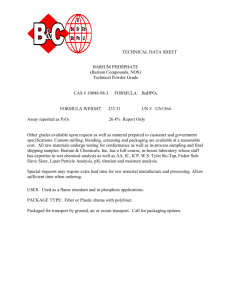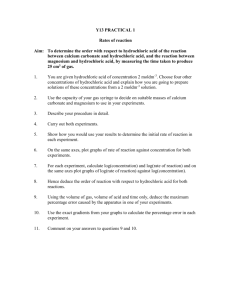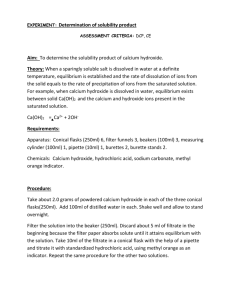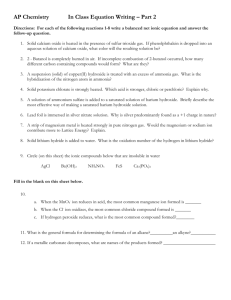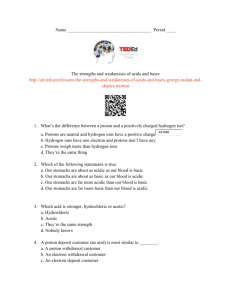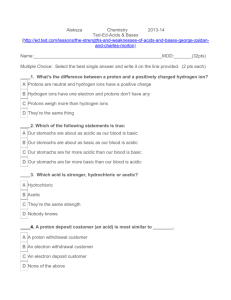Archive/image/ysuba/doc/s.no 60
advertisement
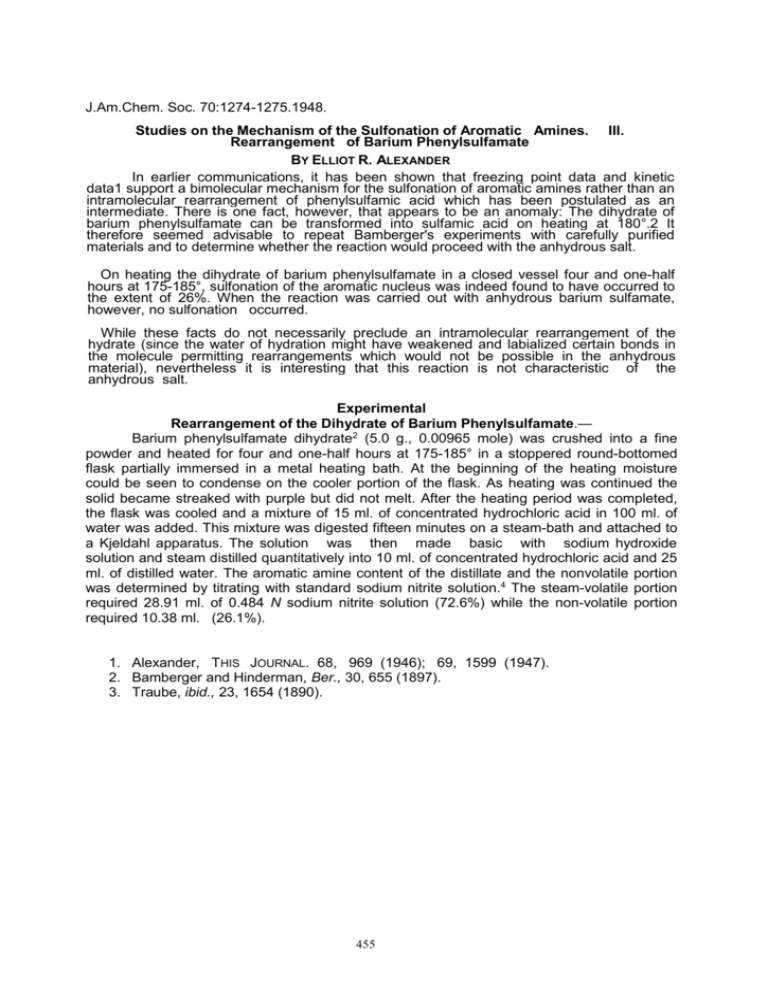
J.Am.Chem. Soc. 70:1274-1275.1948. Studies on the Mechanism of the Sulfonation of Aromatic Amines. III. Rearrangement of Barium Phenylsulfamate BY ELLIOT R. ALEXANDER In earlier communications, it has been shown that freezing point data and kinetic data1 support a bimolecular mechanism for the sulfonation of aromatic amines rather than an intramolecular rearrangement of phenylsulfamic acid which has been postulated as an intermediate. There is one fact, however, that appears to be an anomaly: The dihydrate of barium phenylsulfamate can be transformed into sulfamic acid on heating at 180°.2 It therefore seemed advisable to repeat Bamberger's experiments with carefully purified materials and to determine whether the reaction would proceed with the anhydrous salt. On heating the dihydrate of barium phenylsulfamate in a closed vessel four and one-half hours at 175-185°, sulfonation of the aromatic nucleus was indeed found to have occurred to the extent of 26%. When the reaction was carried out with anhydrous barium sulfamate, however, no sulfonation occurred. While these facts do not necessarily preclude an intramolecular rearrangement of the hydrate (since the water of hydration might have weakened and labialized certain bonds in the molecule permitting rearrangements which would not be possible in the anhydrous material), nevertheless it is interesting that this reaction is not characteristic of the anhydrous salt. Experimental Rearrangement of the Dihydrate of Barium Phenylsulfamate.— Barium phenylsulfamate dihydrate2 (5.0 g., 0.00965 mole) was crushed into a fine powder and heated for four and one-half hours at 175-185° in a stoppered round-bottomed flask partially immersed in a metal heating bath. At the beginning of the heating moisture could be seen to condense on the cooler portion of the flask. As heating was continued the solid became streaked with purple but did not melt. After the heating period was completed, the flask was cooled and a mixture of 15 ml. of concentrated hydrochloric acid in 100 ml. of water was added. This mixture was digested fifteen minutes on a steam-bath and attached to a Kjeldahl apparatus. The solution was then made basic with sodium hydroxide solution and steam distilled quantitatively into 10 ml. of concentrated hydrochloric acid and 25 ml. of distilled water. The aromatic amine content of the distillate and the nonvolatile portion was determined by titrating with standard sodium nitrite solution.4 The steam-volatile portion required 28.91 ml. of 0.484 N sodium nitrite solution (72.6%) while the non-volatile portion required 10.38 ml. (26.1%). 1. Alexander, THIS JOURNAL. 68, 969 (1946); 69, 1599 (1947). 2. Bamberger and Hinderman, Ber., 30, 655 (1897). 3. Traube, ibid., 23, 1654 (1890). 455 Attempted Rearrangement of Anhydrous Barium Phenylsulfamate.—Anhydrous barium phenylsulfamate was prepared by drying the dihydrate for eight hours at 100° and 1 mm. It was analyzed by titration with sodium nitrite solution. 4 Anal. Calcd. for C12H12N2S2O6Ba: NH2, 6.58. Found: NH2, 6.55. This salt (5.0 g., 0.00104 moles) was treated exactly as described above. Three drops of the sodium nitrite solution was required for the non-volatile portion while 42.87 ml. (99.6%) was required for the portion volatile with steam. (4) Kolthoff and Stenger, "Volumetric Analysis," Interscieace Publishers, Inc., New York, N. Y., 1942, p. 240. NOYES CHEMICAL LABORATORY UNIVERSITY OF ILLINOIS URBANA, ILLINOIS RECEIVED AUGUST 25, 1947 The Preparation of 2-Amino-4-hydroxy-6-keto- 5,5-dichlorodihydropyrimidine BY R. B. ANGIER, J. H. MOWAT, J. H. BOOTHS, C. W. W ALLBR, J. SEMB , B. L. HUTCHINGS, E. L. R. STOKSTAD AND Y. S UBBA R OW In connection with the investigation of the synthesis of pteroylglutamic acid1 the compound, 2-amino-4-hydroxy-6-keto-5,5 - dichlorodihydropyrimidine (III), became of some interest. The corresponding2,4rdihydroxy-6-keto-5,5-dichlorodihydropyrimidine (IV) has been prepared by several methods2,3,4 including the direct chlorination of barbituric acid (II) in water solution.4Several attempts to chlorinate 2-amino-4,6-di-hydroxypyrimidine (I) by the use of chlorine in a water solution were unsuccessful. A good deal of decomposition occurred and the small yield of product usually obtained was apparently a mixture of the starting material and the monochloro and dichloro substitution products. When a potassium chlorate and hydrochloric acid mixture was used as a chlorinating agent a reasonably pure 1. Waller, et al. . THIS JOURNAL, 70, 19 (1947). 2. Behrend, Ann.. 236, 64 (1886). 3. Blitz and Hamburger, Ber. 49, 639 (1916). 4. Bock, ibid. . 56B, 1222 (1923). Sample of the monochloro derivative, 2-amino-4,6- dihydroxy-5-chloropyrimidine (V), was obtained. 456 V R = NH2 R' = Cl VI R = NH2 R' = I R = NH2 R = OH R = NH2 R = OH Johnson5 has described the use of a mixture of 30% hydrogen peroxide and concentrated hydrochloric acid to convert 2-amino-4-hydroxypyrimi- dine to 2-amino-4,6dihydroxy-5,5-dichlorodi-hydropyrimidine. By applying this procedure to2-amino-4,6dihydroxypyrimidine (I) the desired product was obtained. Unlike the monochloro derivative or the starting material this compound was rather unstable. In hot water it dissolved and decomposed rapidly with the production of carbon dioxide.6 Therefore in order to demonstrate that the pyrimidine ring was still intact the compound was reduced by two methods. Reduction with hydriodic acid and glacial acetic acid gave 2-ainmo-4,6-dihydroxy-5-iodopyrimidine (VI) while stannous chloride and hydrochloric acid gave 2-amino-4,6 dihydroxypyrimidine (I). Experimental7 2-Amino-4,6-dihydrox7-5-chloropyrimidine (V).—2- Amino-4,6-dihydroxypyrimidine (2.5 g.) was suspended in a solution of 10 cc. of concentrated hydrochloric acid and 15 cc. of water; 1.6 g. of potassium chlorate was added slowly while keeping the temperature at 25-35°. After thirty minutes the product was filtered off, washed with water and dried; yield 1.0 g. This was nearly pure but to obtain an analytical sample it was dissolved in dilute ammonium hydroxide, filtered, and precipitated by adding acetic acid. This was repeated and a white crystalline product was obtained. Anal. Calcd. for C4H4N2O2Cl: C, 29.74; H, 2.50; N, 26.01; Cl, 21.95. Found: C, 29.36; H, 2.52; N, 25.70; Cl, 22.38. 2-Amino-4-hydroxy-6-keto-5,5-dichlorodihydropyrimi-dine (III).—2-Amino-4,6dihydroxypyrimidine (10.0 g.) was suspended in 70 cc. of cold 30% hydrogen peroxide (Superoxol) and 70 cc. of concentrated hydrochloric acid was added. While stirring or shaking the solid slowly dissolved and the solution became warm. This was allowed to react for ten to twenty minutes while keeping the temperature between 40° and 60° by cooling. During this time a crystalline precipitate appeared. (It was necessary to control the temperature of the reaction since if the solution became too hot the reaction became violent and the product decomposed. Even when the temperature was controlled during the initial reaction period if the mixture was allowed to stand at room temperature overnight the product would redissolve and decompose.) The reaction mixture was then well cooled, filtered and the precipitate washed with water, ethanol and ether and dried; yield 6.5 to 8.0 g. (42-52%). The product did not require purification. 5 Johnson. THIS JOURNAL. 65, 1218 (1943). Although 5,5-dichlorobarbituric acid (IV) can be recrystallized from water, Blitz and Hamburger2 have shows that it decomposes slowly in boiling water. 7 The microanalyses were carried out by Mr. Louis Branconc and staff of this Laboratory. 6 457 Anal. Calcd. for C4H3N3CCl2: C, 24.51; H, 1.54; N.21.44; Cl.36.18. Found: C,24.50; H, 1.65; N,21.63; Cl, 35.81. R = NH2 R = OH This compound is insoluble in cold water and in most organic solvents but is somewhat soluble in pyridine. It is insoluble in all concentrations of cold hydrochloric acid. It dissolves in hot water or hot dilute acid solutions and immediately decomposes giving off carbon dioxide. sample of the compound was recrystallized by dissolving it in cold ammonium hydroxide and then acidifying the cold solution with acetic acid. The product crystallized as platelets. Analytical data on this material were the same as before recrystallization. Reduction of 2-Amino-4-hydroxy-6-keto-5,5-dichloro-dihydropyrimidine (III). A. Hydriodic Acid in Glacial Acetic Acid.—2-Amino-4-hydroxy-6-keto-5,5-dichlorodihydropyrimidine (0.5 g.) was suspended in 5 cc. of glacial acetic acid; 5 cc. of hydriodic acid (sp. gr. 1.7) was added and the resulting solution was heated on the steam-bath for thirty minutes. It was then diluted to 50 cc. with water and enough sodium hydroxide added to neutralize the hydriodic acid present. The resulting precipitate was filtered off, redissolved in dilute sodium hydroxide, filtered and precipitated again by the addition of acetic acid; yield 0.4 g. (62%) of a white powder insoluble in water. This material gave a good qualitative test for iodine. Anal. Calcd. for C4H4N2O2I: C, 19.00; H, 1.59; N, 16.61. Found: C, 19.37; H, 2.02; N, 16.74. B. Stannous Chloride in Hydrochloric Acid.—To a suspension of 1.0 g. of 2-amino4-hydroxy-6-keto-5,5-dichlorodihydropyrimidine in 10 cc. of water were added 4 g. of stannous chloride dihydrate and 15 cc. of concentrated hydrochloric acid. This was warmed to 70° for fifteen minutes, cooled, neutralized, and then made distinctly alkaline with ammonium hydroxide. This was centrifuged and filtered to remove the stannous hydroxide. The filtrate was neutralized with acetic acid and a white crystalline product appeared; yield 0.3 g. (47 %). This contained no halogen and had physical properties resembling 2- amino-4,6-dihydroxypyrimidine. To further purify it, it was dissolved in dilute ammonium hydroxide, filtered, and crystallized by adding acetic acid. Anal. Calcd. for C4H5N2O2: C, 37.80; H, 3.97; N, 33.06. Found: C, 37.67; H, 4.35; N, 33.19. All of. these products are characteristic of this type of pyrimidine compound in that they have no melting point but decompose slowly at high temperatures. Also they are all insoluble or only slightly soluble in water and most organic solvents. LEDERLE LABORATORIES DIVISION AMERICAN CYANAMD COMPANY PEARL RIVER, NEW YORK RECEIVED OCTOBER 6, 1947 458 The Reaction of 2-Amino-2-methyl-l-propanol with Sulfuric Acid1 BY ROBERT E. BUCKLES AND GENE V. MOCK The synthesis2 of 2,2-dimethylethyleneimine by the dehydration of 2-amino-2methyl-l-propanol would be expected to be analogous to Wenker's3 synthesis of ethyleneimine. In the latter case the first step of the reaction has been shown to be the esterification of monoethanolamine by sulfuric 1. Part of a thesis presented by Gene V. Mock to the Graduate College of the State University of Iowa. 2. (a) Cairns, THIS JOURNAL, 63, 871 (1941); (b) Karabinos and Serijan, ibid., 67, 1856 (1945); (c) Campbell, Sommers and Campbell, "Org. Syntheses," 27, 12 (1947). 3. Weaker, ibid., 57, 2328 (1935). 459
